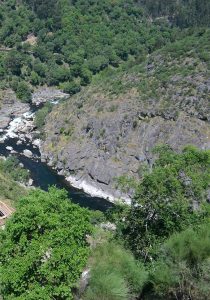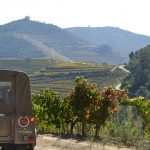Winner of two World Travel Awards, respectively in 2016 and 2017, the Paiva’s Walkways are a route of approximately 8 km full of breathtaking landscapes. Constructed on the left bank of the Paiva River, in the county of Arouca (Aveiro’s district), between the Areinho’s and Espiunca’s river beaches. The Paiva’s Walkways allow to nature lovers the permanent contact with various species of Arouca Geopark’s fauna and flora, as well as with several geologic and archaeological elements of it.
The Arouca’s Geopark is recognized for its amazing Geologic Heritage, interesting at an international level, presenting an huge importance at the educational, touristic, scientific, landscaped and cultural levels. Its area corresponds to all the Arouca’s County territory and contemplates 41 geosites, that are places with big geologic interest, highlighting the Giants Trilobites of Canelas, the Parideiras Rocks of Castanheira and the fossils of the Paiva’s Valley. 47% of its area its classified by the Natura 2000 Network – an ecological network created for the Community Space by the European Union, which has as principal objective to secure the conservation at the long-term of the species and habitats most endangered in all the European territory, composing the principal tool for the biosphere’s preservation in the European Union – divided by the tree places of communitary interest, respectively, Freita and Arado’s mountain (34%), Paiva’s River (10%) and Montemuro’s mountain (3%).
In addition to geology, the Arouca’s Geopark is known for its vast diversity of fauna and flora species. About fauna, there are tons of species that found in the hills, fields, rivers and woods of Arouca the ideal habitat to live free. Stand between a lot of species of birds the cobreira eagle and the round wing eagle, the crow, water’s blackbird, the rock’s blackbird and the vulgar peneireiro. Next to the rivers and streams inhabit various species of reptiles and amphibians, including the horned viper, the mardorado triton, the orange belly’s triton, the sardão and the common frog, the Lusitanian salamander and the yellow points salamander, the green frog, the Iberian frog, the water’s lizard. About small and middle size mammals it is possible to find at Arouca’s Geopark boars and genets as well as red squirrels, wild rabbits and bucks. Butterflies (as euphydryas aurinia and the zebra butterfly) and damselflies (like, for example, the blue gaiteiro) embellish the landscapes with their fluttering pretty colors.
The Arouca Geopark’s flora is of an unparalleled beauty, only it able of adorn the green bottom with pink and yellow floral shades. Between the eucalyptus woods, appears the mountain’s rosemary, the alder, the anarrhinum longipedicellatum, the endeaea frigida and the woods anemone. The arenaria, the avencão and the holly, as well as the yellow bells embellish the landscape along the Paiva Walkways’s route. The carqueja, the alvarinho oak and the chestnut, as well as the fetos-pente, the hammers, the capuz das gemas moss, the loendro and the queiró are some of the species that enrich the Arouca Geopark’s biological heritage, as the wild tulip, the wild pine and the orvalhinha.
Another factor that takes a lot of people to visit this Geopark is its archaeological wealth, once that here exist six really important places. They are the Megalithic Set of Escariz, the Portela da Anta’s Dolmen, the Roman Mine of Gralheira d’Água, the Archaeological Site of Malafaia, the Prehistoric Tumulus of Monte Calvo 2 and the Roman Walk that was been constructed to permit the displacement of people and products between the old city of Olíssipo (the current city of Lisbon) and the old city Bracara Augusta (the current city of Braga).
During the Paiva’s Walkways it’s possible to find, in addition to the various species of fauna and flora, 5 of the 41 geosites of the Arouca’s Geopark, respectively the Paiva’s Throat, the Aguieiras’s Waterfall, the Vau’s River Beach (which is located exactly in the middle of the route), the Gola do Salto and the Falha da Espiunca. The river beaches of Areinho, Vau and Espiunca are not just beautiful, but also the perfect places to dive in the freshness of the crystalline waters of Paiva and experience unique moments of leisure with family and friends.
On the walkways you can always go through by a suspended bridge over the Paiva River, constructed next to the Vau’s leisure area. Is already in construction a suspended glazed bridge with 150 meters high next to the Aguieiras’s Waterfall’s geoplace and in the outskirts of the escarpment titled as Paiva’s Throat. Its structure about 480 meters over the Paiva’s River will be the biggest of its type in Portugal, and many people think that it will be one of the most beautiful of Europe. Only passerby, it is a relevant work not just for the local population of Arouca, but for all the Portuguese territory, because of tourism demand that Arouca’s Geopark and, in particular, the Paiva’s Walkways have got, not just at the national level, but also international.
Arouca is one of the most beautiful municipalities of the Aveiro’s district and even one of the prettiest of Portugal. Right in the center of the village you can found the Saint Mafalda’s Monastery that had been constructed in the 10th century, according to existing documentation, being at that time known as Saint Peter’s Monastery. In 1210 is offered by Sancho I (second king of Portugal) to is sister Mafalda, posteriorly canonized on June 27th of 1793 by the Pope Pio VI, accompanying her sisters, Teresa and Sancha, beatified at the beginning of this century, on December 13th of 1705. Although the rule adopted in the Arouca’s Monastery was initially Saint Benedict’s (“ora et labora” – pray and work), from the 12th century onwards it was adopted the Order of Cister’s rule, which was held until the final of the 19th century. In the 15th and 16th centuries were realized various reconstruction and expansion works in the Monastery, detaching between all its spaces, because of its beauty, the church, the nuns chorus and the cloisters, as well as the Museum of Sacred Art that exists there, where is possible to find various cult objects, including manuscripts, and various pieces of art such as sculptures, paintings, tapestries and pieces of jewelery. Since 1886 the Saint Mafalda’s Monastery stopped hosting nuns, at the time of death of the last one who lived there. It was in the convent that several conventual recipes were born, that enrich the Portuguese gastronomy and more specifically the Portuguese pastry. Based on almonds and eggs, detaching between them the sweet chestnuts, the nun’s bellies, the almond roscas and charutos, the sweet morçelas and the Saint Bernard’s bola.
Alvarenga is one of the 16 villages of the Arouca’s Municipality, having been between 1514 and 1836 county seat then constituted by the villages of Alvarenga, Canelas, Espiunca and Jenarde. Bathed by the Paiva´s River, Alvarenga is one of the most beautiful lands of the Arouca’s Geopark. Is, therefore, the ideal destination to walk with family on a sunny day, to practice extreme sports, BTT walks, between other outdoor ludic activities. Known because of its gastronomic offer, just there you can appreciate the best of the gastronomic heritage of Arouca: the Posta Arouquesa, the Green Wine and the Pinguça. The Arouquesa’s breed, natural of the municipality of Arouca (as the name itself indicates), is an autochthonous Portuguese bovine specie that since ever contributes in the life of the local residents of Arouca, providing them with meat, milk (indicated for the production of butter) and cooperation in the agricultural works. Its juicy meat is known because of its unique flavor having been the only Portuguese product awarded in the Grand Paris Exhibition in 1878, where it gained great fame. The tasty Green Wine, exclusive of the Demarcated Region of the Green Wines in the northwest of the Portuguese territory, is produced only from the Arouca’s native grape varieties, dividing into several types, including White Wines, Red Wines, and Pink Wines, detaching also the Sparkling Wine and the bagaceira brandy, both produced from the same. It is in the center of the village of Alvarenga, in the Eduardo de Noronha Dias Distillery, where born the famous Pinguça – an housemade gourmet liquor produced through the traditional method, without the addiction of chemical compounds, but with carefully selected ingredients, that ensure its unique quality and flavor. It was an idea that was born in a group of friends whose use the lands of their parents and grandparents to generate agricultural micro productions, from which they harvest the necessary ingredients to produce the Pinguça. Available in various flavors, including honey, chocolate, red fruits, passion fruit and cinnamon, Pinguça is a product that pretends to promove the region and its economy, stimulating the local agricultural production and the creation of rural jobs.
Arouca is the perfect destination for who looks for the balance between nature, adventure and the best of the Portuguese gastronomy. Go through the Paiva’s Walkways is an unique experience that permits to discover the diversity, not just biological, but also geologic and archaeological of the Arouca’s Gepark, as well as enjoy of the most beautiful landscapes, dive in the crystalline waters of the Paiva River and taste the best regional flavors.
Begin your day with a convenient pick up at your hotel followed by a one and half hour drive to the start of this great trail. Your personal guide will give you great insights about life in Portugal and our ways and traditions making the way to the Paiva Walkway go by in a flash! After this 3 hours hike, a great lunch is required! Taste the best meat in Portugal at Alvarenga, famous for its “Posta Arouquesa”, a delightful piece of grilled beef that will make you regain all your stamina!
Come with us and meet also the remaining territory Arouca Geopark recognized by UNESCO as a Geological Heritage of Humanity.
Admire the incredible scenery and become immersed in the natural wonder as your guide points out areas of geologic, natural, and archaeological interest.











